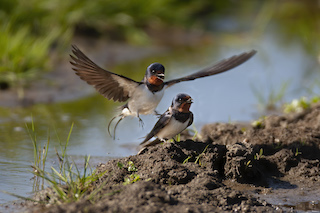 Swallows are always an uplifting sight in the spring and throughout the summer.
Swallows are always an uplifting sight in the spring and throughout the summer.
Photo: © Richard Birchett
Scientific name: Hirundo rustica
Other common names: Barn Swallow
Cornish name: Gwennel
Conservation status: UK Birds of Conservation Concern, green
What to look for:
- Colouring and appearance: Dark blue back, russet-coloured throat and chin, pale breast. The long forked tail streamers are very distinctive in flight, and are longer in males.
- Size: Up to about 20 cm in length.
- Where: In the summer, across the UK in suitable habitat (such as open grassland and farmland where there is a good supply of insect food, and near to buildings and other potential nesting sites).
- Call: Trilling and twitters.
- Similar species: Swift, Sand Martin and House Martin: the swallow’s tail streamers are however more prominently forked, and there are colouring differences.
 As they soar and dive acrobatically through the sky, it is easy to imagine that Swallows are flying for the sheer joy of the wind across their wings as they arrive back here from their wintering homes in southern Africa. They swoop through the air as they hunt for insect food, and drink on the wing as they skim water surfaces.
As they soar and dive acrobatically through the sky, it is easy to imagine that Swallows are flying for the sheer joy of the wind across their wings as they arrive back here from their wintering homes in southern Africa. They swoop through the air as they hunt for insect food, and drink on the wing as they skim water surfaces.
The males arrive first to the breeding areas and choose their nest sites. Pairs are generally formed anew each year: one of the criteria the females use to select a mate is the length of the males’ forked tails – the longer the better, as this signals a strong healthy bird. Although socially monogamous while raising their young during the breeding season, birds often copulate outside their pairing. Each brood of about 4 to 5 chicks is raised in the Swallows’ cup-shaped mud nests. Originally cave breeders, Swallows have now adapted to using human habitations, and are found nesting under the eaves of roofs or inside farm outbuildings.
 Such a familiar and enigmatic bird has a strong presence in our folklore tradition. Swallows flying low are supposed to herald bad weather (which has a basis in truth, as they are known to hunt on or close to the ground to find prey in rain, when insects are less likely to be flying). More bizarrely, the fact that large flocks of the birds often roost in reed beds at the end of the summer once led to the belief that they spent the winter at the bottom of lakes: this was before we understood that their winter absence was explained by their southward migration.
Such a familiar and enigmatic bird has a strong presence in our folklore tradition. Swallows flying low are supposed to herald bad weather (which has a basis in truth, as they are known to hunt on or close to the ground to find prey in rain, when insects are less likely to be flying). More bizarrely, the fact that large flocks of the birds often roost in reed beds at the end of the summer once led to the belief that they spent the winter at the bottom of lakes: this was before we understood that their winter absence was explained by their southward migration.
Did you know…?
…Dedicated parenting: Swallows fetch food for their chicks several hundred times a day.
…There are six subspecies of Hirundo rustica. Hirundo r. ssp. rustica is the one we are familiar with in the UK, but we are also sometimes visited by the Egyptian subspecies, H. r. ssp. savignii, which has a strongly rufous rather than pale breast.
More information and references:
Gooders, J. and Harris, A., 1986. Field Guide to the Birds of Britain and Ireland. Kingfisher Books, London.
Published: April 2014 (updated June 2020)
Author: Amanda Scott
Photos: upper: © Allan Drewitt / Natural England; lower: © Richard Birchett
